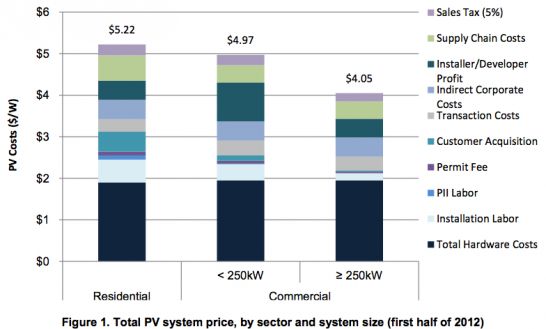California just moved a bit closer to reducing some of the "soft costs" of installing solar with an assembly bill meant to streamline permitting and inspection for small residential solar systems.
As solar hardware costs have plummeted, overhead (or "soft costs") have become the majority cost piece of the installation. Soft costs are challenging to tease out of a bill of materials and more difficult to eliminate, as they straddle municipal government, building codes and human labor and behavior. The litany of soft costs includes supply chain costs, installation labor, customer acquisition, permitting, inspection, interconnection, subsidy applications and system design costs.
A DOE report from 2012 claims that inconsistencies in permitting processes can cost consumers up to $2,500 on a 5-kilowatt rooftop solar system. A study by Lawrence Berkeley National Labs concluded that streamlining the permitting process could potentially reduce the price of a residential solar system by $1,000 or more and cut development time by about a month. The dollar-per-watt cost of solar in the U.S. is still significantly higher than in Germany, in some part because states, counties, and municipalities in the U.S. have an inconsistent, time-consuming, and costly permitting process.
FIGURE: Average Total Residential Permitting, Inspection, and Interconnection Costs

Source: NREL
But California is doing something legislatively to address the costs of inspection, interconnection and permitting. AB 2188, authored by Assemblymember Al Muratsuchi (D-Torrance), just passed the California Assembly with a vote of 52-5 and moves now to the Senate's Governance and Finance Committee. The bill has to make it through two committees and pass the Senate floor by August 31 in order to make it to Governor Jerry Brown's desk.
The bill aims to cut soft costs associated with permitting and inspections of solar energy systems with the following measures:
- The bill mandates that cities and counties adopt an ordinance that creates an expedited, streamlined permitting process for residential rooftop solar energy systems of less than 10 kilowatts in size.
- For a small residential rooftop solar energy system eligible for expedited review, only one inspection would be required, and that inspection will be scheduled within five business days after request.
- For systems that qualify for expedited review, the permit process would include a simple checklist that would be published online, along with list of other required documents.
- An application that meets the requirements in the checklist will be reviewed within 24 business hours. Submittal of the application would be over-the-counter or online, and handled within 24 hours of submission.
Solar financier Sunrun wrote in a 2012 report that the wasted money from permitting inefficiencies functions like a $1 billion tax on solar. The cost stems from the time spent by installers in obtaining the building, zoning, and fire department permits, waiting for inspection and utilities, dealing with changes -- and losing customers in the process. Sunrun's Ethan Sprague has said that solar should "be more like installing an appliance than rewiring a house."
Vermont (pop. 630,000) enacted a law in 2012 that provided a simple and consistent permitting process that can get solar deployments approved in ten days. The new registration form covers system components, configuration, and compliance with interconnection requirements.
Kelsea Jones, deputy director with the California Solar Energy Industries Association, said in a release: “From Chico to Chula Vista, we’re talking about the exact same product, design, and installation, yet many building departments require Byzantine permits as if they are installing a nuclear power plant up there."
“Streamlined permitting doesn’t mean weaker consumer protections,” said Tom Butts, City Councilmember in Richmond, California, in a release. “Local governments run more smoothly by applying practical, tried-and-true efficiency measures to the permitting system.”
The League of California Cities opposes the legislation, citing safety and cost issues. Some of the group's concerns include:
- The bill would require cities and counties to "adopt a new, costly ordinance that would essentially create a separate permitting and inspection process specifically for residential solar installations of less than 10 kilowatts."
- Requiring "every local jurisdiction to uniformly issue solar permits and inspect solar installations within five days of the request would be very problematic and costly for many local governments," according to the group. "A local jurisdiction’s ability to process a permit application and complete an inspection in an expedited manner is largely driven by available funding and trained staff."
- "Eliminating the permit review process would prohibit cities from involving their fire department or utility department in the permit approval process, thus removing a jurisdiction’s ability to verify that no fire hazards are present and the installation complies with all applicable fire codes."
- AB 2188 "could jeopardize this proven process by forcing cities and counties to potentially overlook shortcomings in solar permit applications or installations in order to comply with the bill’s highly restrictive approval timeline."
The 1978 California Solar Rights Act declared that the “implementation of consistent statewide standards to achieve the timely and cost-effective installation of solar energy systems is not a municipal affair...but is instead a matter of statewide concern.” The permitting process governing the installation of rooftop solar energy systems varies widely across jurisdictions, and many observers claim that contrary to the intent of the law, it is both an “obstacle” to the state’s clean energy and greenhouse reduction goals and a “burdensome cost” to homeowners, businesses, schools, and public agencies.
The DOE SunShot program is looking to get solar to $1.00 per watt installed. That can't happen without a standardized and sensible permitting process.
FIGURE 2: Total PV System Price by Sector and System Size, 1H 2012

Source: NREL



